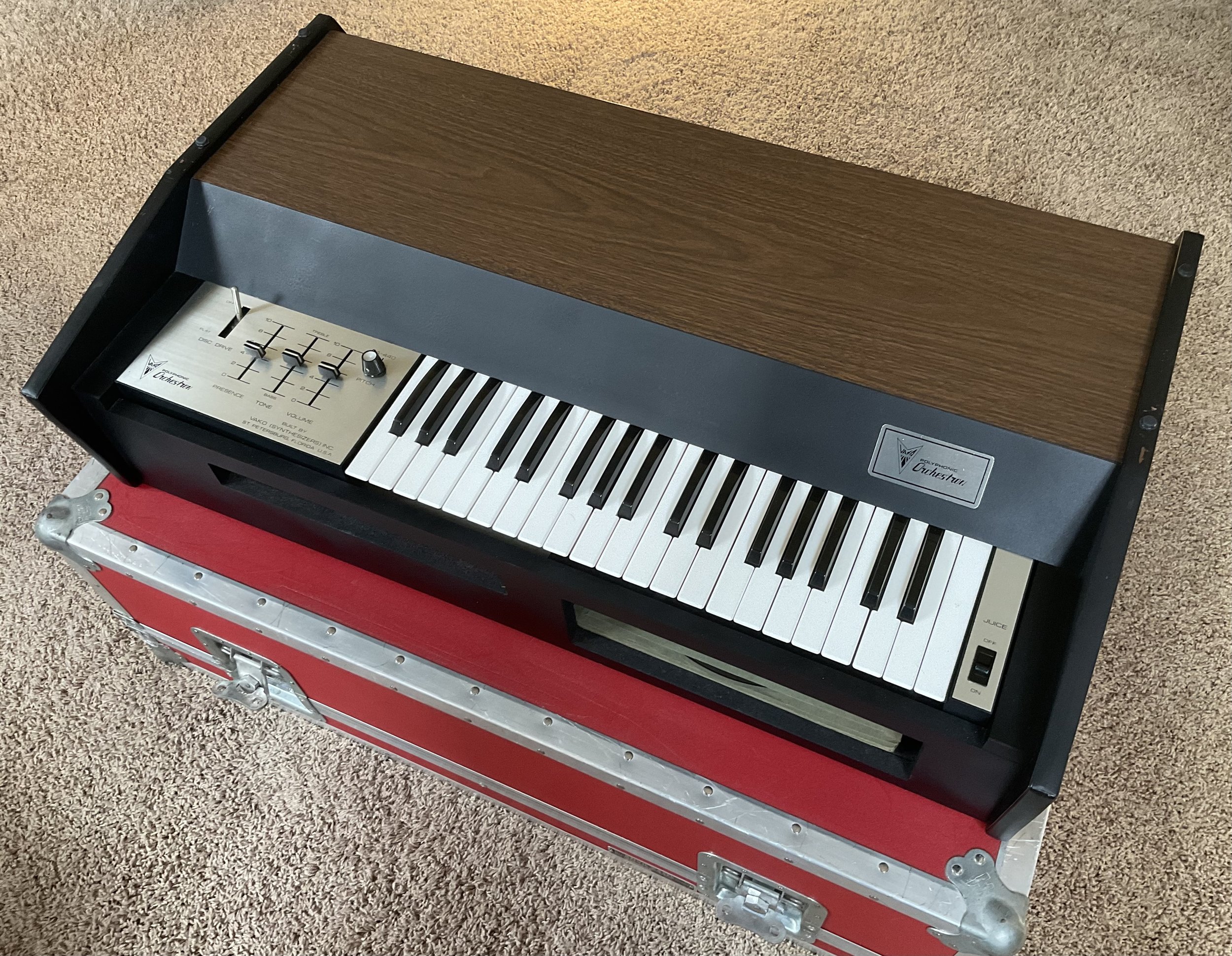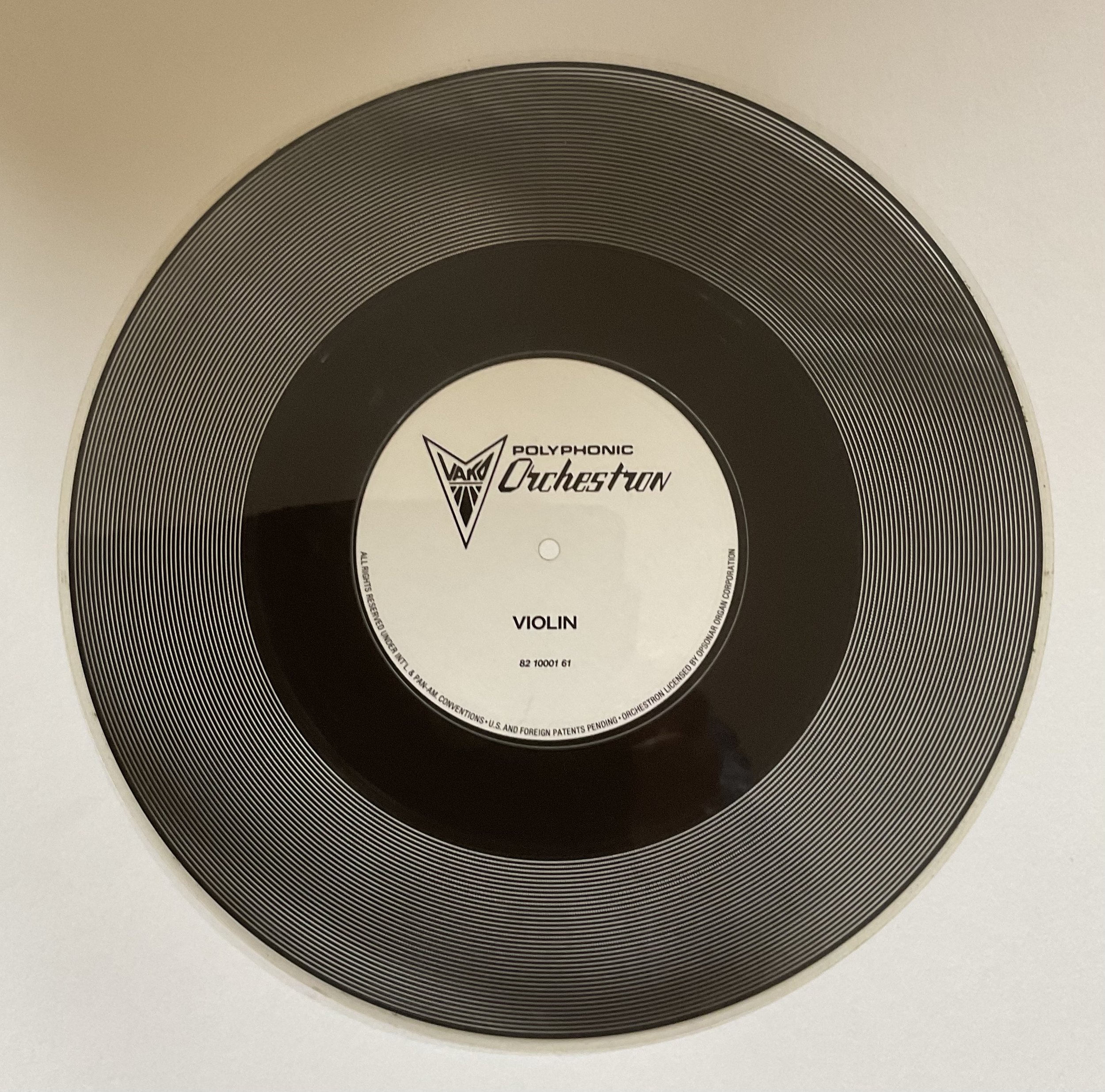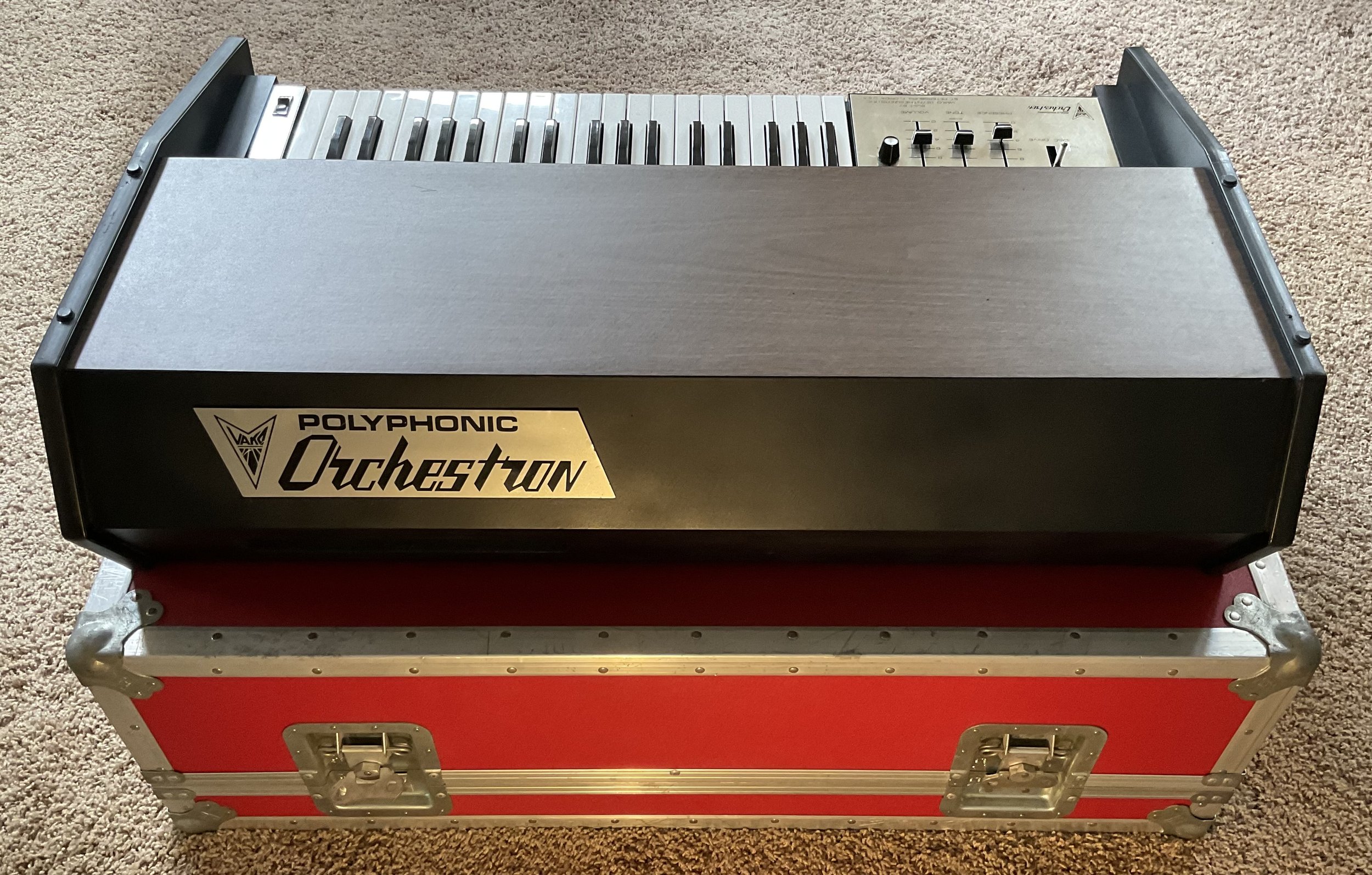Vako Orchestron
My Vako Orchestron with Anvil road case
The Vako Orchestron story actually starts with an instrument called the Optigan (Optical Organ), which was developed by a subsidiary of the Mattel toy company starting in 1968. The Optigan employed optical disc technology to produce a variety of instrument sounds, which was rather innovative at the time, and was conceived as a scaled-down, lower-cost option to the electric organs being offered by manufacturers such as Hammond, Baldwin, Lowrey, and Wurlitzer. I remember my grandmother, who played piano and organ at her church, bought an Optigan in the early 70’s because it was affordable, easy to move around, and small enough to fit in her modest apartment. She was thrilled to finally have a keyboard she could play at home, but I also remember her never being completely satisfied with the Optigan, primarily because of the small keyboard, plastic construction, and lackluster sound quality compared to a real piano or church organ.
Stock photo of an Optigan. This looks just like the one my grandmother owned.
Whereas the Optigan was targeted for the consumer electronics market, the Orchestron was intended to be an improved, professional-level instrument targeted for working musicians. Development of the Orchestron was led by David Van Koevering, who Wikipedia describes as an “electronic instrument pioneer and former Moog technician and salesperson”. Van Koevering founded Vako Synthesizers in St. Petersburg, Florida and started producing the Orchestron under license in the mid-1970’s.
David Van Koevering business card
An original Vako Orchestron ad. List price of $1995 (plus another $200 if you wanted four additional discs) was not exactly cheap in 1975.
The Orchestron could be considered an early version of a sampling keyboard in that it played actual recordings of various instruments such as Pipe organ, Flute, French horn, Violin, Cello, and Vocal choir, among others. Similar to its Optigan predecessor, the Orchestron utilized an optical reader and a soft-plastic optical disc containing transparent and opaque squiggly lines - variations in light intensity as it passed through the optical disc would be detected and translated into an electronic audio signal. Each optical disc was prerecorded with the sound of a particular instrument played across the musical scale, allowing each key of the Orchestron to “play” that corresponding note. Discs were placed on a turntable housed inside the Orchestron’s cabinet and could be swapped in and out as easily as changing an LP on your record player.
A typical Orchestron optical disc. As you can see, this one is for Violin.
I bought my Orchestron in December of 1980 from Atlanta Discount Music. Discount Music always seemed to have a pretty good selection of used equipment back then, and I had gone there in search of a used Mellotron. The Mellotron sound I was really after was the Vocal choir sound you would sometimes hear on various Prog Rock albums of the 70’s - the songs “Fly On A Windshield” by Genesis and “Big Brother” by David Bowie are good examples. I loved that sound – still love it today. I told the salesperson at Discount Music what I was looking for, and he said I might be interested in a used Orchestron that he had. I had never heard of an Orchestron, and when he took me over to look at it, I was a little skeptical. It had a relatively short, 37-key keyboard (same as a Mellotron, actually), but was housed in a brownish, wood-grain cabinet with faux-finish antique brass handles. My first reaction was that this was some sort of one-off or homemade instrument. The salesperson told me how the Orchestron operated with the optical discs and everything, and he plopped in some of the discs that came with it – one of which was the Vocal choir. I was sold instantly. I paid the asking price of $350 (I’m not sure I even negotiated) and was soon on my way home with an instrument that I didn’t even know existed when I had entered the store less than an hour earlier.
I must say today that I am very proud to be an Orchestron owner. Unfortunately, Vako Synthesizers went out of business after only a couple of years of production. They did not produce many of these instruments (some sources suggest only ~100 were produced), and when they do come up for sale the asking price is usually pretty high – often thousands of dollars. My Orchestron is a Model B, and I used it quite a bit for recording and live gigs in the 80’s. The discs I used most often were the VocaI choir (of course), as well as the Pipe organ and Violin. I didn’t like the stage look of the brown, wood-grain cabinet, so I painted my Orchestron black sometime in the early 80’s. Recently, though, I’ve thought about restoring it back to its original wood-grain grandeur. The black paint on the upper surface of the cabinet had already started to flake off, and I’ve been able to remove the remainder by gently scraping with my thumbnail. The rest of the paint seems to be better adhered to the underlying surface, however, so I’ve stopped for now - that’s why my Orchestron has a funky, two-tone finish. I may just keep the two-tone finish as homage to the history of this particular instrument.
I still use my Orchestron today. Most recently, I used it for the Vocal choir on my song “Spring Day Chapparal”, which can be heard at Spring Day Chaparral | The Future of the World (bandcamp.com). I still have all eight of the original optical discs that came with my used Orchestron, but over the years I’ve also purchased a number of new, limited-run discs produced by Pea Hicks and offered on his website Orchestron – Optigan. They all sound great!
When I purchased my Orchestron over 40 years ago it was missing the “Vako Polyphonic Orchestron” nameplate that was normally affixed to the cabinet. Those nameplates were glued on, and I’m guessing the one from my Orchestron simply fell off at some point before I purchased it. Although the nameplate obviously has no effect on functionality or sound, it always bugged me that it was missing. I searched far and wide over the years for an original nameplate, but I knew such a search was very much like finding the proverbial needle in a haystack, especially given the relatively low number of Orchestrons that were produced in the first place. Well, lo and behold, in December 2023 I saw the Vako nameplate I was searching for being offered on Ebay! I couldn’t believe it, and I was lucky enough to win the auction! It turned out that nameplate was being offered by a fellow named Brian Kehew WELCOME (briankehew.com). Brian is a musician, music historian/author, music producer, and recording engineer extraordinaire, and the owner of Round & Wound Studios in North Hollywood Analog Tape Transfer to Digital | Round and Wound. Brian had known David Van Koevering personally, and he was kind enough to reach out to me after the auction to share a binder of historical documents and photographs related to the Vako company and the development of the Orchestron that had been given to him by the Van Koevering family after David passed away in 2018.
The original Vako Polyphonic Orchestron nameplate I found on Ebay after years of searching. My life is now complete (and so is my Orchestron).
I’m happy to say my Orchestron is in excellent shape for a near 50-year-old instrument, especially after being hauled all over the place and used for live gigs in the 80’s. For that, I credit the Anvil road case that I custom-ordered soon after I bought the instrument. The Orchestron is somewhat bulky and not particularly lightweight, but back then I thought nothing of hauling it around, setting it up (along with a bunch of other equipment), playing several sets that might total 3-4 hours, and then breaking it all down. Keep in mind there were no roadies involved – the band did everything. Today, it seems like a major accomplishment to just get my Orchestron out of its road case and set it up. The only plausible explanation I can come up with is that my Orchestron has somehow gotten heavier over the years.
My Vako Orchestron - poised for another 50 years of making music






